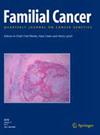内镜超声在检测高危人群胰腺病变中的作用
IF 1.8
4区 医学
Q3 GENETICS & HEREDITY
引用次数: 0
摘要
胰腺导管腺癌高危人群有资格在研究计划内接受监测。这些项目采用磁共振成像/磁共振胰胆管造影术或内窥镜超声波等形式进行定期成像,以检测早期癌症或高级别前驱病变。这篇叙述性综述讨论了内镜超声在这些监控计划中的作用。它详细介绍了内镜超声的总体优势和局限性、产量、对患者造成的负担以及与磁共振成像的比较。最后,还就何时以及如何将内窥镜超声纳入高危人群的监控中提出了建议。本文章由计算机程序翻译,如有差异,请以英文原文为准。
The role of endoscopic ultrasound in the detection of pancreatic lesions in high-risk individuals
Individuals at high risk of developing pancreatic ductal adenocarcinoma are eligible for surveillance within research programs. These programs employ periodic imaging in the form of magnetic resonance imaging/magnetic resonance cholangiopancreatography or endoscopic ultrasound for the detection of early cancer or high-grade precursor lesions. This narrative review discusses the role of endoscopic ultrasound within these surveillance programs. It details its overall strengths and limitations, yield, burden on patients, and how it compares to magnetic resonance imaging. Finally, recommendations are given when and how to incorporate endoscopic ultrasound in the surveillance of high-risk individuals.
求助全文
通过发布文献求助,成功后即可免费获取论文全文。
去求助
来源期刊

Familial Cancer
医学-遗传学
CiteScore
4.10
自引率
4.50%
发文量
36
审稿时长
6-12 weeks
期刊介绍:
In recent years clinical cancer genetics has become increasingly important. Several events, in particular the developments in DNA-based technology, have contributed to this evolution. Clinical cancer genetics has now matured to a medical discipline which is truly multidisciplinary in which clinical and molecular geneticists work together with clinical and medical oncologists as well as with psycho-social workers.
Due to the multidisciplinary nature of clinical cancer genetics most papers are currently being published in a wide variety of journals on epidemiology, oncology and genetics. Familial Cancer provides a forum bringing these topics together focusing on the interests and needs of the clinician.
The journal mainly concentrates on clinical cancer genetics. Most major areas in the field shall be included, such as epidemiology of familial cancer, molecular analysis and diagnosis, clinical expression, treatment and prevention, counselling and the health economics of familial cancer.
 求助内容:
求助内容: 应助结果提醒方式:
应助结果提醒方式:


